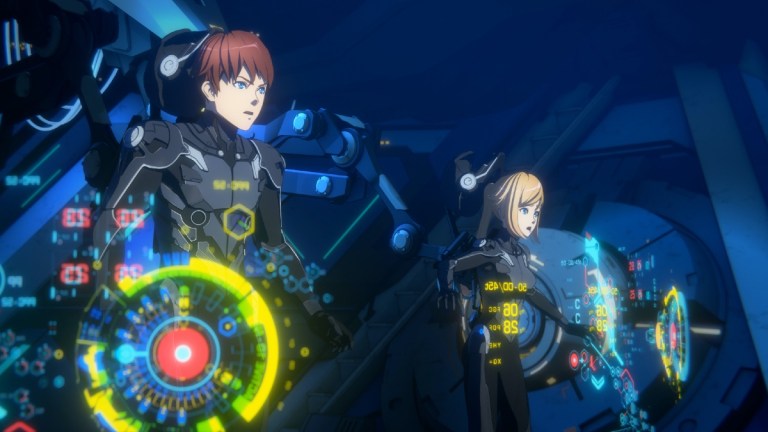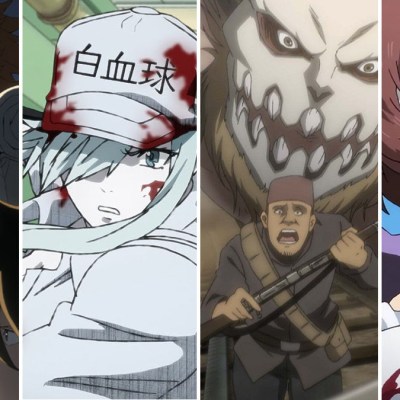Pacific Rim: The Black Review (Spoiler-Free)
A new Pacific Rim animated series explores the post-apocalyptic remains of a post-kaiju Australia, but fails to capture the original del Toro magic.

This review contains no spoilers and is based on the first three episodes of PACIFIC RIM: THE BLACK season 1.
Guillermo del Toro’s neon-drenched monsters-vs-robots epic Pacific Rim wore its influences proudly on its elbow cannon-equipped sleeves, so an anime-style spin-off makes a certain kind of inevitable sense. Pacific Rim: The Black is a seven-episode Netflix Original that seeks to expand the Pacific Rim mythology – think “extended universe” rather than “sequel”.
Created by Thor: Ragnarok co-writer Craig Kyle and X-Men: Evolution head writer Greg Johnson, the show follows siblings Hayley (Gideon Adlon) and Taylor Travis (Calum Worthy) as they struggle to survive in a post-apocalyptic, kaiju-infested Australia.
A quick introductory voiceover establishes the setup: after multiple new Breaches appeared on the continent, the Pan Pacific Defence Corps cut its losses and moved out of Australia entirely. A half-hearted evacuation pulled out some survivors; the rest were abandoned. Hayley and Taylor’s parents were Jaeger pilots, so after plonking their kids down in a sheltered and idyllic-looking grotto, they went to seek help… but never came back.
Fast forward five years, and the kids’ illusion of safety is shattered by the discovery of a forgotten training Jaeger, quickly followed by the arrival of a kaiju. With nowhere left to hide, the teens are forced out into the wreckage of the world, where a whole set of unimaginable new nightmares await them.
Animated by Tokyo-based studio Polygon Pictures, Pacific Rim: The Black is a beautifully designed show. That’s probably its biggest selling point. You could grab almost any frame and get something beautiful: the backgrounds are stunning, even when the kids are trudging through scenes of total destruction, and the kaiju are properly monstrous, all terrifying silhouettes and glowing blue highlights. Hayley and Taylor themselves are fairly generic – your stock anime protagonists with improbably spikey hair and enormous glistening eyes – but at least they’re expressive.
Where things start to get a bit wobbly is in the action. It all feels a little stilted, at least in the first three episodes; things just don’t look as good in motion as they do in isolated stills, which makes the action sequences feel oddly detached. That’s potentially a massive problem, because much of the story’s momentum comes from the emotional aftermath of horrific kaiju battles. To connect with the Travises’ plight, you’ve got to really feel the desperation and terror they’re feeling – and that doesn’t quite come across.
If you’re willing to put in a bit of emotional homework, though, the story so far is heartbreaking, and looks set to get even more so. It does feel a little like the odds are stacked too highly against these kids; with the opening monologue still ringing in your ears, the idea that a couple of inexperienced teens might be able to fight their way out through a series of gaping monster-portals seems, well, a little unrealistic. But then that’s the fun part, too. How are they going to survive? What secrets are there out there? And what did happen to their parents? If Kyle and Johnson can figure out a way to make those impossible odds feel a bit more possible, the payoff could be spectacular. But it’s definitely a tough brief.
Dedicated Pacific Rim fans might find themselves perplexed by some of the liberties the show takes. Just like in the live action sequel Pacific Rim: Uprising, it seems like the writers have felt like they needed to shake things up, to add new threats or complicate existing ones, rather than just working with what they were given. It’s all pretty unnecessary, given that the first movie offered so much potential for extra stories set in its universe. The entire world had to face an unprecedented threat; people had to rethink how they related to one another and what they valued; they had to learn to build giant robots!
It’s always felt like that first movie was overstuffed with ideas, like it was overflowing with characters whose backstories would have been fascinating to explore, and yet so far, every expansion of the story has ignored all those possibilities in favor of trying to make up its own new set of rules. Viewers new to the universe might find that less troubling, but for fans, it’s like a neighbor’s kid coming round to play with your toys and deciding to rename half of them, and give the others new superpowers.
More fundamentally, there seems to be a big difference in the way del Toro’s movie saw humanity and the way this show does – and, arguably, Uprising did, too. Based on those first three episodes, Pacific Rim: The Black looks set to trundle off down a well-worn post-apocalyptic path, to tell a story where humanity itself is more treacherous and evil than any external threat. How many times now have we done this whole routine where the real villains turned out to be us?
Maybe the final four episodes are going somewhere more interesting. Maybe Craig and Johnson have got something else to say, maybe there’s something more innovative to explore here. But if not, then that’s what’s going to really set this apart from del Toro’s original sad-but-hopeful vision of humanity.
And, not to get too political in a review of a sci-fi TV show, but in these terrifying times, wouldn’t you rather be told a story of how a battered and grieving population nonetheless decided to put their trust in one another to work for a better world than one where everyone just saw the apocalypse as one more way to exploit one another?
All 7 episodes of season one of Pacific Rim: The Black will be available to stream on Netflix from 4 March.

